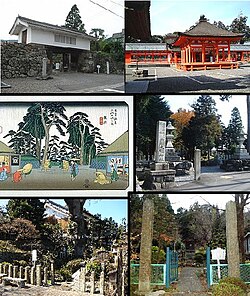Town in Chūbu, Japan
| Tarui 垂井町 | |
|---|---|
| Town | |
 Clockwise from top: Shigekado Takenaka's Jinya, Nangu Taisha, Tairyo Shrine, Site of Morichika Chosokabe's Jinya, Mineral Spring in Tarui, Picture of Tarui Traditional Inn in Edo Period Clockwise from top: Shigekado Takenaka's Jinya, Nangu Taisha, Tairyo Shrine, Site of Morichika Chosokabe's Jinya, Mineral Spring in Tarui, Picture of Tarui Traditional Inn in Edo Period | |
 Flag Flag Seal Seal | |
 Location of Tarui in Gifu Prefecture Location of Tarui in Gifu Prefecture | |
 | |
| Coordinates: 35°21′59″N 136°32′17″E / 35.36639°N 136.53806°E / 35.36639; 136.53806 | |
| Country | Japan |
| Region | Chūbu |
| Prefecture | Gifu |
| District | Fuwa |
| Government | |
| • Mayor | Mitsuya Nakagawa |
| Area | |
| • Total | 57.09 km (22.04 sq mi) |
| Population | |
| • Total | 27,439 |
| • Density | 480/km (1,200/sq mi) |
| Time zone | UTC+9 (Japan Standard Time) |
| City symbols | |
| - Tree | Japanese zelkova |
| - Flower | Camellia |
| Phone number | 0584-22-1151 |
| Address | 1532-1 Tarui-chō, Fuwa-gun, Gifu-ken 503-2193 |
| Website | Official website |

Tarui (垂井町, Tarui-chō) is a town located in Fuwa District, Gifu Prefecture, Japan. As of 1 December 2018, the town had an estimated population of 27,439 and a population density of 480 persons per km, in 10,525 households. The total area of the town was 57.09 square kilometres (22.04 sq mi).
Geography
Tarui is located in far southwestern Gifu Prefecture, at the western end of the Nōbi Plain of Japan. The town has a climate characterized by hot and humid summers, and mild winters (Köppen climate classification Cfa). The average annual temperature in Tarui is 15.0 °C. The average annual rainfall is 1904 mm with September as the wettest month. The temperatures are highest on average in August, at around 27.5 °C, and lowest in January, at around 3.7 °C.
Neighbouring municipalities
- Gifu Prefecture
Demographics
Per Japanese census data, the population of Tarui peaked around the year 2000 and has declined slightly since.
| Year | Pop. | ±% |
|---|---|---|
| 1970 | 23,240 | — |
| 1980 | 26,404 | +13.6% |
| 1990 | 28,605 | +8.3% |
| 2000 | 28,935 | +1.2% |
| 2010 | 28,505 | −1.5% |
| 2020 | 26,402 | −7.4% |
History
The area around Tarui was part of traditional Mino Province. Numerous Jōmon period and Kofun period remains have been found in the area, which was the site of the Nara period provincial capital and Provincial temple. During the Edo period, Tarui-juku prospered as a post station on the Nakasendō highway connecting Edo with Kyoto. The town of Tarui was formed on 1 July 1889 with the establishment of the modern municipalities system. The 1891 Mino–Owari earthquake caused considerable damage to the area. Tarui annexed the neighboring villages of Iwate, Fuchu, Miyashiro, Osa, and Aihara in 1954. The 1959 Isewan Typhoon caused severe damage to the town.
Education
Tarui has seven public elementary schools and two public middle schools operated by the town government, and one public high school operated by the Gifu Prefectural Board of Education.
Transportation
Railway
Highway
Sister cities
 Calgary, Alberta, Canada, since July 1996
Calgary, Alberta, Canada, since July 1996
Local attractions
- The Beauty of Tarui, a video portraying the major sites of Tarui
- Mino Provincial Capital Site, A National Historic Site
- Nangū Taisha, the ichinomiya of Mino Province
- Tarui Ichirizuka. a National Historic Site
References
- ^ まちのプロフィール > まちの概要. Tarui official website (in Japanese). Archived from the original on 19 March 2012. Retrieved 12 August 2011.
- Tarui town official statistics (in Japanese)
- "Tarui climate data". Archived from the original on 25 December 2017. Retrieved 13 September 2024.
- "Tarui population statistics". Archived from the original on 3 November 2020. Retrieved 13 September 2024.
External links
- Official website (in Japanese)
| Gifu (capital) | ||
| Core city | ||
| Cities | ||
| Districts | ||
| List of mergers in Gifu Prefecture | ||
This Gifu Prefecture location article is a stub. You can help Misplaced Pages by expanding it. |